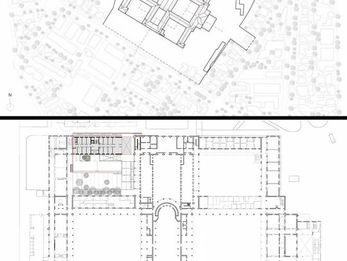2016 Americas Prize

Faculty of Arts Academic Building, Pontificia Universidad Catolica de Chile
Fernando Perez-Oyarzun, Jose Quintanilla-Chaia
Santiago, Chile
May 2015
AUTOR PRINCIPAL
Fernando Pérez-Oyarzun
AUTOR CONTRIBUYENTE
Monica Flores, Luis Lucero, Carolina Rodríguez (Collaborators)
CLIENTE
Pontificia Universidad Católica de Chile
FOTÓGRAFO
Juan Purcell-Mena José Quintanilla-Chala
OBJETIVO
The building was conceived as a simple volume, in favor of an easier construction and to avoid competing with the existing building. A kind of infrastructure, provided with flexible plans and an energy efficient skin. We sought for certain rusticity and a particular combination of concrete and brick masonry, the original materials of the campus. We propose a double wall box, with inner air chamber, and post tensed slabs, with no columns inside. Inner divisions, which can be easily moved, are made of timber and glass panels. Their delicacy contrasts with the rusticity of the exterior. The new building has been separated from the old one for technical and formal reasons. A small bridge connects the third floor with the old corridor and a west connection has been considered for the future. Distribution and form of the façade's openings respond to the layout of inner spaces, the existing building scale and the energy efficiency (less than 50 % of openings to avoid thermal gains). Reception offices and meeting rooms have been located in the two first floors. In the third floor there are the dean’s and head of the school’s offices, along with their staff. The four floor is again a place of offices and meeting rooms. The upper terrace, provided with a meeting area, is conceived as a social space. It allows contemplating the urban landscape and the imposing Andes. Slight changes in the width and position of the circulations, allows each floor to have its own identity.
CONTEXTO
The building had to appear as if it were always there. That was the main intention. The project is located in a 1926, brick and reinforced concrete neo-Romanesque complex. The original project remained uncompleted. The northwestern patio lacked the northern wing. This was the location chosen by the university for the new Faculty of Arts Academic Building. The building had to allocate offices for academics from the Arts, Music and Theater Schools, as well as their authorities and the Dean’s office. The project completes the patio, as in the original project, adapting it to present needs. It also provides a new double height connection with the garden and sport area, adjacent to which an exhibition room is located. The idea was to respect the height and width (11 m.) of the original building. For this, the four-floor volume was located partially underground, to allocate the whole program and facilitate the connection of its third floor with the second of the old one. That decision, and the requirements of the brief, led to generate a minor parallel underground volume and accommodate a small garden and an entrance space in between them. This gave a new character to the old patio, which was provided with an upper level area, acting as a kind of performing space.
ACTUACIÓN
The users took possession of the building during the second semester 2015. It was immediately and generally well received. They were able to identify the design intentions to integrate the building into the existing environment. This was a central point: there was great concern of the community on that respect. The patio has been envisaged as a more vivid space where performances can take place and the new connection with the sport area, enriches the circulation scheme of the campus. There, the art gallery can be extended for exterior exhibitions, making the passing by an exciting experience. The working conditions were in general considered adequate. The brief asked for a very dense office layout. A few double heights and the upper terrace were provided to make the building breath in functional terms. However, the fact that not all the academics work at the same time, has helped to reach a good work climate. The thermal inner conditions have performed as they had been modeled, confirming the original expectations. The double walls and their materials provide an adequate thermal inertia and the windows size avoid an excess of thermal gains. This is helped by the recession of the northern windows. This new academic building has allowed the university to plan the re-use of other campus spaces. They will accommodate a new extension center, having a significant and positive impact on the surrounding urban area. Therefore, being a very punctual and localized intervention it acts as a kind of acupuncture with wider urban effects.











